
by Katinka | Jul 28, 2014 | 2014, Adoption, Adoptive Parents, Being Thankful, Belgium, Birth Parents, Childhood, Contest, Cooking, Cultural Differences, Discipline, Ethiopia, Family, Food, Health, Kids, Life Balance, Motherhood, Multicultural, Nutrition, Parenting, Siblings, World Motherhood, Younger Children
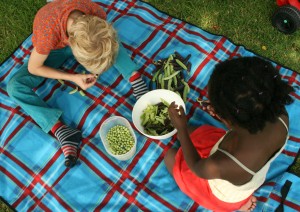 I’ve yet to meet a mom who is not monitoring her kid’s eating habits. Some might even be obsessed over it, others just make sure their kids eat enough or don’t overeat. Food can be filled with cultural, health or moral values and seems an important subject in most families I know.
I’ve yet to meet a mom who is not monitoring her kid’s eating habits. Some might even be obsessed over it, others just make sure their kids eat enough or don’t overeat. Food can be filled with cultural, health or moral values and seems an important subject in most families I know.
Every single one of the moms I know, seems to have her personal truth about food, or is at least searching for it. I know quite a few moms who vouch for strict vegetarianism, sugar free, all organic, low-carb, macrobiotic, low-fat or a mix of those. Others cook without lactose, gluten, sugar, eggs, nuts, soy and other allergy or intolerance boosters, by necessity or by conviction. But there’s also quite a number who just like to stick to their grandmothers’ favourite mashed potatoes with pork chops and piccalilli, because that’s what they were raised with.
Myself, I mix quite a bit of the above. My life is all about compromises. As a student, I used to be vegetarian, but now we eat vegetarian for only about 3 days a week. I also restrict the amount of lactose, because of my daughter’s (mild) intolerance. I make sure they eat at least one piece of fruit per day, but most days it’s two or three. And because we are Belgian, we have our two-weekly take out of ‘French’ fries, which originally came from Belgium. Or maybe even from Flanders.
I would not call myself obsessed, but I do keep a detailed mental track of what my kids eat in a day, and try to compensate by the 80/20 rule I adopted from a fellow World Mom: if they eat healthy for 80% of the time, that will make up for the 20% they eat junk.
When a mom has found her personal truth about food, obviously she wishes for her kids to eat by it; which they aren’t likely to do without a struggle. Not after they’ve tasted the Belgian fries, they won’t.
When my oldest was younger, I used to think I had it all together though. He ate whatever vegetable I gave him and his favourite dish was Brussels’ sprouts. I even recall quite some occasions on which I, the former vegetarian, bribed him into eating his meat by promising him an extra stem of broccoli. After a while, even the meat didn’t pose a problem anymore. He would eat whatever I served him.
Those good old days are over now.
It all started when our daughter arrived, age 2.5. She came from Ethiopia and was not used to our diet, not mentally, but also not physically. The first time I served her something green, she just threw it on the floor. Not out of a whim, but because she was clearly convinced it was not edible. She even tried to take it out of my mouth. Having been fed mashed dishes all her life, she was also not used to chewing. She did like bread and she did her best chewing it, but we had to take her to a physiotherapist to sooth her jaw pains. So we customized our cooking to her and introduced new stuff every once in a while. The one dish that never posed a problem was, indeed, our Belgian fries.
Meanwhile, our son, then 5, seemed to finally grasp that there was such a thing as rejecting food. I don’t know whether it was his sister’s example, the TV shows he started watching, his classmates or just normal evolution, but he started getting more selective each month. He also ate with his hands more often, just like his sister was used to. I went from having one kid with excellent eating habits to two picky, messy eaters.
After two years of convincing myself it was just a phase, this year I started implementing some strategies to get them to eat more balanced. Ultimately, what they were eating wasn’t all that bad but I was getting tired of the drama and the struggle to get them to eat what I believed was good for them. And most of all, I wanted them to develop the discipline to choose healthy by themselves, and not just because I ordered or rewarded them.
First, I tried the Yucky List. A colleague of mine had it at home, and it worked perfectly for her family. The idea is that it is only natural to have different tastes and that you don’t need to like everything. The concept is that each family member can have three dishes they really don’t like, on that list. When it is served, they are allowed to refuse it and have bread instead. Or hope for a mom who cooks two different dishes in advance. Of course over time, you can change your preferences but when a fourth dish you don’t like is served to you, you have to eat it, before you can put it on the list (replacing another).
It seemed promising but after a few weeks, the kids started to change their list about every other day. Way too many family dinners were filled with ‘I will put this on my yucky list for sure!’ and a lot of moaning and struggling, which didn’t really lighten the mood as I had hoped it would. We might pick it up again when they are older but for now, it doesn’t work for us.
After that, I changed my strategy to handing out a Yucky Coupon, Bah Bon in Dutch. I borrowed the idea from a friend who used to do cooking for youth camps. At these camps, each of the kids was given one Bah Bon for the duration of the camp. They could hand it in if they didn’t want to eat one of the meals that was cooked for them. Of course, they only could do that once. And the ones who still had the Bah Bon at the last day of camp, could hand it in, in exchange for ice cream.
So that’s how we do it now and it works like a charm! The kids both have their weekly Bah Bon, which is very conveniently posted on the magnetic wall next to the dinner table. Whenever they complain about dinner (or lunch or breakfast), we just point to their Bah Bon and remind them they can hand it in if they wish. No strict words, just giving them a choice and a visual reminder. Our son hasn’t missed his Sunday ice cream once. Our daughter has, once, and she’s not likely to miss another.
Of course, this will only work if ice cream is really a treat for your kids. Mine don’t really get candy or other sweets that often, so for them this works perfectly.
And of course, it’s still kind of a bribe. But I like it much more than the daily ‘If you don’t eat it, you can’t have desert’ bribe. For one, because we don’t have desert every day. Second, because they have to manage the discipline to work all week for their ice cream, rather than getting an instant reward. Third, because I don’t exactly sell the ice cream as a bribe or reward but rather as an interpretation of the 80/20 rule: if they eat healthy and balanced all week, it is all right to have something unhealthy every once in a while.
Most importantly, I like this system because the kids themselves really like this system. They like being in control of what they (don’t) eat without any pressure from us, and most of all they absolutely love our weekly ceremony when they officially hand in the Bah Bon they saved in exchange for their well deserved treat.
Do you have a personal or cultural take on the food you serve your kids? And do you need similar strategies to convince them about it?
This is an original post to World Moms Blog by K10K from The Penguin and The Panther.
The picture in this post is credited to the author.
If you ask her about her daytime job, Katinka will tell you all about the challenge of studying the fate of radioactive substances in the deep subsurface. Her most demanding and rewarding job however is raising four kids together with five other parents, each with their own quirks, wishes and (dis)abilities. As parenting and especially co-parenting involves a lot of letting go, she finds herself singing the theme song to Frozen over and over again, even when the kids are not even there...
More Posts

by Maureen | Jul 24, 2014 | 2014, Eye on Culture, Indonesia, Scoops of Joy, World Motherhood

An Indonesian father with child
Would you believe me if I tell you I have NEVER heard of Father’s Day until I moved to America in 2005.
Yes, true story!
Here in Indonesia we just simply don’t have Father’s Day.
We do have Mother’s Day on December 22, 2014. The holiday is celebrated on the anniversary of the opening day of the first Indonesian Women Congress, which was held from 22 to 25 December 1928. The Congress was attended by 30 feminist organizations from 12 cities in Java and Sumatra. In Indonesia, feminist organizations have existed since 1912, inspired by Indonesian heroines of the 19th century, e.g., Kartini, Martha Christina Tiahahu, Cut Nyak Meutia, Maria Walanda Maramis, Dewi Sartika, Nyai Ahmad Dahlan, Rasuna Said, etc. The Congress intended to improve women’s rights in education and marriage.
We also have Kartini Day on 21 April to celebrate the emancipation of women spearheaded by an activist, Raden Ajeng Kartini.
So why do we have no Father’s Day then?
Could it be because we as a country are already too patriarchy?
I actually wonder about that too. So like a good citizen, I turned to Google and did a little research.
What do you know, actually we do have one and it’s called “Hari Ayah” in Indonesian which means Father’s Day. It was declared in 2006 it falls on 12 November. That explains why very few people are aware of this and it’s not popular. Maybe because we don’t commercialize it as much as mother’s day? I have never seen an advertisement for local Father’s Day.
Technically, men still perceived to have higher place than women in Indonesia. Like it or not, that’s the truth. We are still plagued by social injustices caused by a male-dominated society that abandons women to the whims of their husbands. So maybe that’s why it is more ‘common’ to celebrate Mother’s Day.
Being from a whole intact family unit of a father and a mother doesn’t guarantee that the father is always hands-on, and I think this happens in many different countries, too. I have personally seen mentally checked out fathers who leave all the responsibilities of raising children solely to their wives by justifying they are too busy making a living for the family. Many men still believe their fatherhood role is simply to provide for the family and that’s it. I feel for women who literally are acting as single parents in a married-life.
Being a mother myself, I can truly appreciate a man who helps out his wife. I celebrate hands-on fathers, like my own father. My father is a strong dominant male figure to me and many people will be surprised by how hands-on he has been. I can still recall him changing my brothers’ diapers, doing the dishes (something he still does to this very day!) and other domestic chores without complaining, going to the market for my mother and many more. He was even actively involved in our schools’ boards. He works hard, yet, he was and is always there.
And now seeing my own younger brother being very hands-on in caring, raising his first daughter truly warms my heart. My sister-in-laws’ friends pointed out that their own husbands do not even want to change diapers, but my brother changes diapers and more.
This made me realize how lucky we are to have our father as a big role model who set great living standards of what a great father is like.
So although Father’s Day is not hugely popular here, I salute all men who break the stereotype of fatherhood in my country. Hats off to you!
When do you celebrate Father’s Day in your country? How do you celebrate Father’s Day?
This is an original post by our World Mom, Maureen of “Scoops of Joy” in Indonesia for World Moms Blog.
Photo Credit: http://www.stockvault.net/photo/152311/asian-child-with-father

by Karyn Wills | Jun 23, 2014 | 2014, Awareness, Being Thankful, Brothers, Childhood, Culture, Education, Eye on Culture, Kids, Multicultural, Music, Nature, New Zealand, School, Siblings, Traditions, World Motherhood
 It’s mid-winter in New Zealand. The air is crisper than I’ve felt it for a while, the leaves have pretty much fallen and we have had the shortest day of the year.
It’s mid-winter in New Zealand. The air is crisper than I’ve felt it for a while, the leaves have pretty much fallen and we have had the shortest day of the year.
This week also saw the appearance of the star cluster, Matariki, (The Pleiades), which heralds the Maori New Year.
This was not a festival I had ever heard of growing up but it has been revised and reinstated and there are now celebrations being held all around New Zealand. While different tribes traditionally celebrated Matariki in their own fashion, now it is universally marked by the new moon and rising of the Matariki star cluster with festivities running from 1st June to 30th July.
Traditionally, Matariki was a time of celebration, important for navigation and the timing of the seasons. It was particularly relevant to the preparation of the ground for the upcoming growing season and offerings to the gods, and specifically, Rongo, the Maori god of cultivated food.
Only a few New Zealand schools consistently mark mid-winter and Matariki but for our boys’ school, festivals are an important part of the culture and I have two mid-winter events to attend this coming week.
On Wednesday evening, my youngest son has a lantern walk through a public garden. Imagine a waterfall and a large pond with a bridge over it and a stream running throughout. Imagine 30 or so small (3-6 year-old) children clutching a paper lantern with a candle in one hand and a parent’s hand in the other as we meander through the park in, otherwise, pitch black. We will wander past tiny grottos of handmade gnomes and crystals, we will attempt to sing (although for the children, it’s enough that they manage to walk and stay upright!) and we finish gathered together, munching on a star shaped, ginger or shortbread biscuit.
On Thursday evening, my older sons have their mid-winter festival, beginning with a shadow play performed by their teachers. After the play, the children who are between 10 and 14 gather in small groups amongst the trees at school and the youngest children, guided by their lanterns and teachers, meander from group to group and hear the older children entertain them with a song, or a poem or a tune. The 10 year-olds then follow behind the youngest to see the older children’s performances and the 11 year-olds follow them, and so on. They will finish with their classmates and a biscuit and warm drink.
The magic in these events is heart-warming and the children just seem to absorb the atmosphere; they appreciate the small snippets of light amongst the darkness, the companionship, the quiet musicality of the ’entertainment’ and especially the sharing of food at the end! (So do I.)
Do you celebrate mid-summer and mid-winter? How do schools where you live mark these seasonal events?
Sources: NZ Ministry of Culture and Heritage; Wikipedia
This is an original post to World Moms Blog by our writer and mother of three boys in New Zealand, Karyn Van Der Zwet.
The image used in this post is credited to Wikipedia images with editing from Dayne Laird (Ministry for Culture and Heritage, NZ)
Karyn is a teacher, writer and solo mother to three sons. She lives in the sunny wine region of Hawke’s Bay, New Zealand in the city of Napier.
More Posts

by ThinkSayBe | Jun 12, 2014 | 2014, Africa, Awareness, Being Thankful, Communication, Discipline, Education, Expat Life, Eye on Culture, Family, Girls, Humor, Older Children, Parenting, Technology, Teenagers, ThinkSayBe, USA, World Motherhood
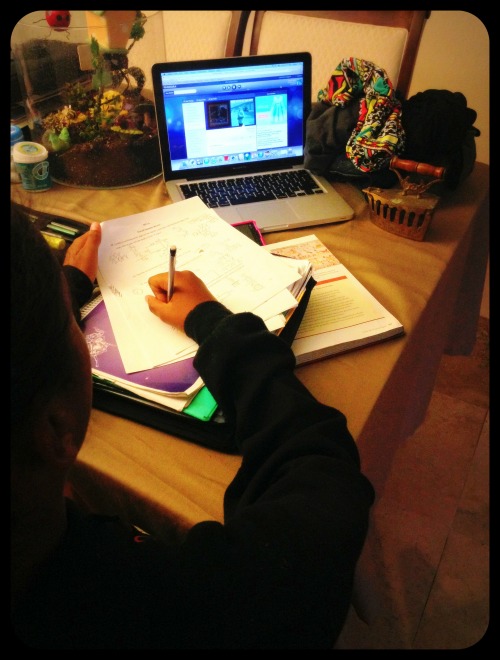
“But mom, why can’t I do my homework in front of the TV??? I’m not watching it, I’m just listening to it!!”, says my 12-year-old girl, emphasizing the word ‘watching’ with a half roll of the eyes.
My daughter is a really cool human & a great child. She is a tween so craziness and challenges come with the territory. Still, she has sweet moments, and she “OKs” everything, whether she remembers later or not.
But, my life was very different growing up in Italy and then Tanzania…
By age 9 my older brother & I alternated daily chores. We had to do dishes & sweep daily. There was no dillydallying, no talk-back, no having to dry our hands to like a song on Pandora…. none of that. We did homework on the kitchen table, our beds, in the yard, and wherever else. After I was done with homework I’d have to use the house phone, speak to a parent with good phone manners, & find out if my friends could come play. There was no texting them.
Everyone knew our plans; at least initially (smile). Outside we used our imagination to play with nothing. We picnicked under a tree in this huge sunflower field. We rode our bikes in circles in the bus’ parking lot and made sure we were home when the lights came on.
When I was 11 we moved back to Tanzania. Life here was drastically different, yet, in some respects there was more access to things than we had in the small Italian town we lived in. However, constant electricity and running water were gone. We had a western toilet in our home, but often had to use toilets requiring squatting, be they a hole over a sceptic tank, or an Eastern latrine. Not having water & electricity all the time required planning.
Though there was hired help, we also had to fetch water. If you don’t like fetching water you learn to use it sparingly. You take a shower from a bucket that’s a quarter full and come out clean! You recycle water so that first you wash your hair by dipping it into the bucket, then use the same water as the first cycle of your laundry, which you wash by hand. Having city-wide rationed electricity, meant ensuring you have kerosene, wick for lamps, and match sticks. You actually needed plenty of match sticks in Tanzania, because there is this one brand that makes them and you’re lucky if one out of five matches actually lights up & stays lit. HAHA!
We must see these things as humorous. Lack of electricity and paying for it in advance, meant using it responsibly. The radio would be on, and so would the TV for some parts of the day. We knew to close the fridge fast and to unplug the iron as soon as the job was done. Ironing was not always done with an electrical iron, either. Some times we would use a charcoal iron. It sounds like it’s from an entire different era, right? It’s still being used. A charcoal cast iron had to be used carefully. You’d also plan how to get hot coals so instead of wasting charcoal, kerosene fuel, and good match sticks, you’d use the charcoal for cooking. That required planning as well. A lot of planning and patience for a youngster, and children had to consider all these things from toddlerhood!
I am so infinitely grateful we lived this kind of life in my teenage years. Though I am sure I threw crazy hormonal arrows (figuratively speaking) at my mom, I think that having to deal with these realities made me get myself together quickly, thus sparing her six years of teenage craze. As far as school goes…wow! We had mandatory knee-high socks & buffed black shoes, mandatory hair pleats that I never had, monitors & prefects who thrived on their power to make us kneel for ‘misbehavior’, and hit-happy, switch-carrying teachers in the hallways who would whack you for no good reason.
In elementary school we had to chant….slowly & loudly…..”GOOD MORNING TEACHER!” Then we’d answer & ask, “FINE THANK YOU TEACHER, AND HOW ARE YOU, TEACHER?”, then we’d be permitted to sit down. In boarding school we had exactly 30 minutes to eat. The first year we ate food we individually cooked the night before, hoping it was still good without refrigeration. As a senior, food was made for us, so we’d hope it was ready & that we didn’t have to scoop bugs out of our beans. We’d always wash our dishes before returning to class. All of this, in 30 minutes.
At this school there was no corporal punishment. However, if we were late or didn’t follow other rules, we’d have some agricultural work for at least one period.
We studied in the hall after we cleaned our dinner mess. After two hours of supervised solid studying, we’d return to our hostel rooms (mine had four bunk beds with three beds each), and lights were out by 10pm. Everyone took showers in the morning, which I found to be unnecessary as the water was very cold, so I would leave some water in the courtyard for the sun to heat , and take a shower after school.
When I came to the United States I didn’t think I had a different work ethic than anyone else. I thought we all work hard & have different struggles. As the years passed I began to see certain differences & felt extremely fortunate for my history as it was.
As a girl I was lucky that my mother (who is partially Afghani & Punjabi) didn’t believe that I was worthless, blessed that she believed in education and sent me to school. I was also fortunate that I wasn’t betrothed at a young age, or at all. As I was in college I understood that I was privileged and had to make other women proud.
I would have to get the best grades, be a well-rounded student & not take electricity and running water for granted. So when my daughter asks why she can’t do her homework in front of TV, I don’t know what to say! OK, I do answer her, trying to use logic she’ll understand. She visited Tanzania for a few months in 2010, but she cannot relate to my history.
When my daughter was round age four she always asked if she could help with chores, but as I tried to rush I’d ask her to draw or play instead. I thought the environment around us would do for her what it did for me at her age. I knew I wasn’t in Italy, or in Tanzania, but I still thought I wouldn’t be the only one pushing for a balanced human. I also didn’t anticipate technology advancing so incredibly fast & how much gadgetry she would have at her disposal. In retrospect I should have encouraged her willingness to help.
She is now 12, doesn’t like to do any chores other than the occasional Swiffer mopping. She wants to do homework while listening to TV, somehow ignoring the visuals, and she wants to spend her other homework time listening to pop songs. She does practice Brazilian Jiu Jitsu and has a unique passion for it. But when not doing her school work, she looks at photos with funny quotes, watches short videos, and messages her friends on her phone. Our lives are so different. How do I teach her what I’ve been taught?
Is it drive? Is it thirst? Can you relate? How do you teach your children how to work hard? Please share your findings with me!
This is an original post to World Moms Blog by Sophia in Florida, USA. You can find her blogging at Think Say Be and on twitter @ThinkSayBeSNJ.
Photo credit to Trocaire. This photo has a creative commons attribution license.
I am a mom amongst some other titles life has fortunately given me. I love photography & the reward of someone being really happy about a photo I took of her/him. I work, I study, I try to pay attention to life. I like writing. I don't understand many things...especially why humans treat each other & other living & inanimate things so vilely sometimes. I like to be an idealist, but when most fails, I do my best to not be a pessimist: Life itself is entirely too beautiful, amazing & inspiring to forget that it is!
More Posts
Follow Me:


by Purnima Ramakrishnan | Jun 11, 2014 | 2014, Brazil, Cultural Differences, Culture, Eye on Culture, India, Purnima, Sports, The Alchemist, World Interviews
Every four years, a large part of the world’s attention descends on one nation – for World Cup Football. Tomorrow, the FIFA World Cup actually starts, and as you all know, the first match is in Sao Paulo, where Brazil takes on Croatia. I was on the phone with fellow World Moms Blog editor, Jennifer Burden, and she asked me if India is excited for the World Cup.
My own family has World Cup fever, inspired by my recent trip to Brazil to report on world poverty and environmental issues, but when I think of the whole of India excited about something sport-related, it is really only cricket that comes to mind!
People in India will watch the World Cup games, but it won’t compare to our country’s level of excitement over cricket.
When it comes to sports, India is a cricket-crazy nation.
INDIA.IS.A.COMPLETE.CRICKET-CRAZY.NATION!
Men, women and kids all watch and/or play and/or have favorites and/or conduct mass prayers and/or do just crazy things for the sake of cricket. There is really no end to it!
Sachin Tendulkar, a cricket player, is like a God to everyone in India. And there is absolutely no limits to what people would do for cricket. It is not just a game. Cricket has a very special life and a very special relationship with this country. It cannot even be explained, however, living in India during the cricket season would say it all.
Let me entertain you with a few crazy things that go on in India around cricket…
People color themselves with the tricolor Indian flag. The tricolor theme is not just clothes and caps, but you can find it also in the school premises, in apartments (flats) — theentire nation in is the colors of the Indian flag for the cricket. The celebrations are as intense, if not more, (ok, I have to be honest- it is the most celebrated event) than even Diwali or the Independence Day.
Check out this picture of a school in Western India where the school children are rooting for the Indian cricket team.
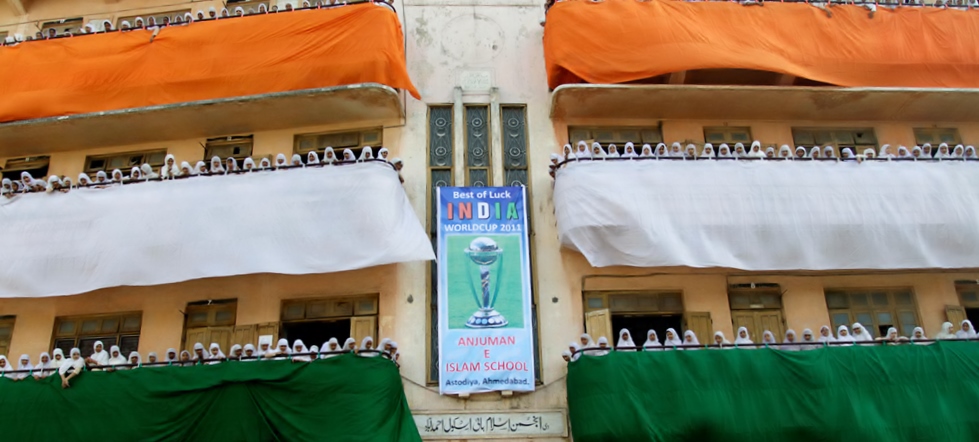
And then people just form throngs everywhere during the actual time the game is telecast. Office-goers, housewives, school-children, get together wherever there is a TV and watch. Homeless people watch cricket on the TV sitting on the streets across an electronics shop (or TV shop). No, they aren’t driven away. Because it is cricket season.
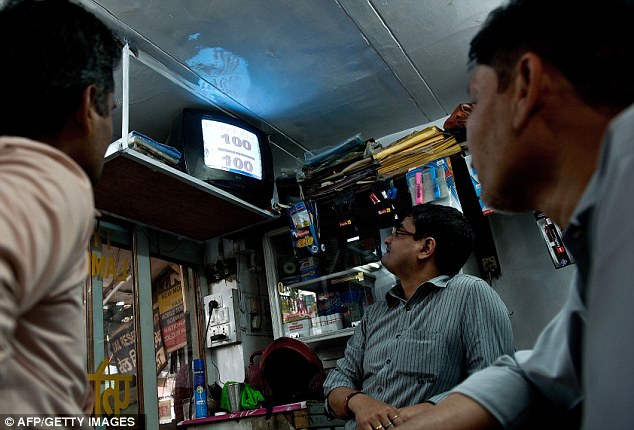
Shopkeepers let the customers watch the match from the shop indefinitely
There are common TV viewing holes in villages like the local tea-stalls, community centers, even movie theaters at times, a common TV in the square of the slum. Oh, there is no end to this kind of thing. These pictures to do the job of explaining the craziness cricket causes for the people of India and the rest of sub-continent countries (Pakistan, Sri Lanka and Bangladesh).
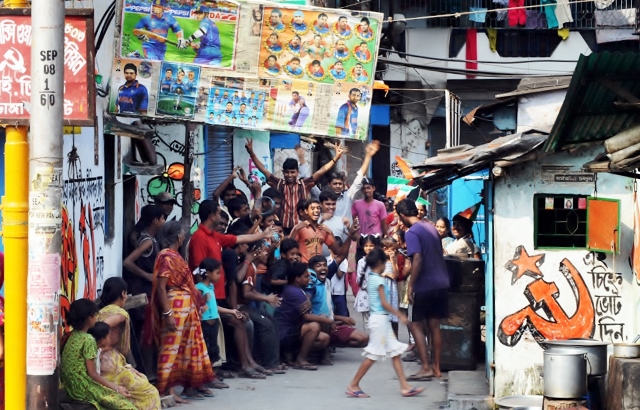
A tea stall hosting the TV viewing of the cricket match to a gathered crowd of the villagers
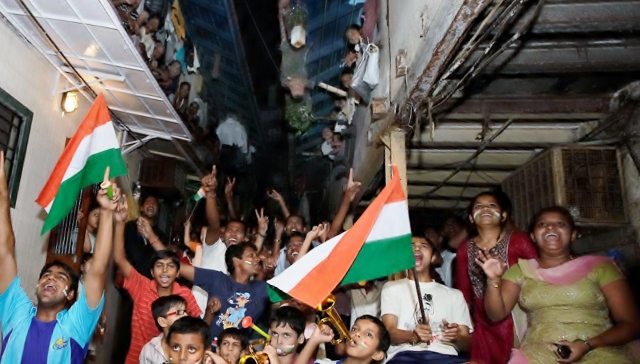
The slum dwellers watching the cricket match from a local TV-hole in the slums.

This is a mall in Kolkatta where the finals of the match between India and Sri Lanka is viewed.
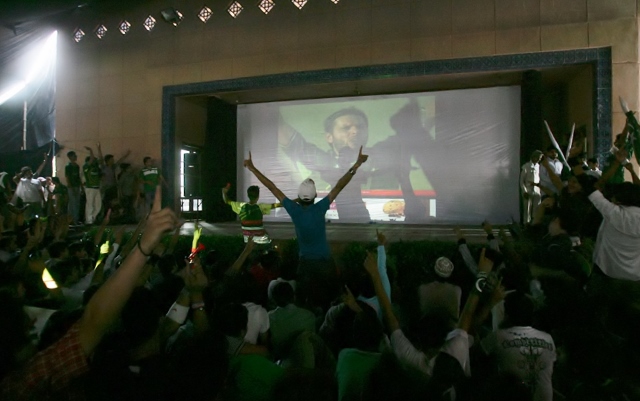
This is a movies theater in Karachi, Pakistan where cricket is telecast during the cricket season.
So, now coming back to the FIFA World Cup to be held in Brazil, all that I would say is that, the temperature is slightly lukewarm in comparison to the fever of the cricket playing nation.
Yes, we do talk a lot about it. But I guess that is about it. And, perhaps, some real football fans would watch it because they are really that – football fans.
By the way, did you catch Brazilian World Mom, Eco Ziva’s, post on the World Cup this week?
So what happens in your country? Is it a football-crazy country too? Or does your country live for some other sport?
Photo credit to the author, The Daily Mail and The Atlantic.
This is an original post to World Moms Blog written by Purnima Ramakrishnan, our Senior Editor from India.
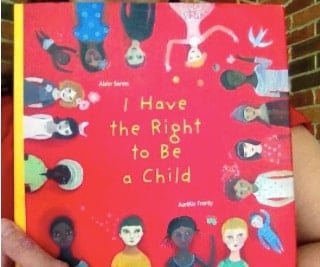
by Cindy Levin | Jun 10, 2014 | 2014, Childhood, Human Rights, Humanitarian, International, Kids, Multicultural, Social Equality, Social Good, United Nations, World Voice

I’ve recently introduced a picture book into my family’s reading time called “I Have the Right to Be a Child” by Alain Serres. With beautiful simplicity, the book provides the author’s interpretation of the United Nations Convention on the Rights of the Child. The Convention includes things like rights to education, gender equality, nutrition, health care, free speech, freedom from child labor, safety, etc. For kids, the book is a conversation starter about human rights. We talked a lot about the question, “What are rights and what are privileges?” For adults, the book is a reminder that these concepts really are not that complicated. It may be complicated in the implementation of granting rights, but when the rights themselves are asserted in the simple language of the children the Convention seeks to protect, it all becomes much more clear.

This is probably the first time my kids saw human rights presented in a way that was meaningful to them. In American museums and text books, the right to vote for women and people of color seems faraway and a “done deal.” They don’t think of those rights as things we continually need to address here and in other countries. My children often help me advocate to give children in developing countries access to school and vaccines, but the language of “rights” isn’t always included in those kinds of discussions.
My youngest really latched on to the page that said,
“I have the right to express myself completely freely, even if it doesn’t always please my dad, and to say exactly how I feel, even if it doesn’t always please my mom.”
We have a lively ongoing debate about how that plays out. If she has the right to express herself completely freely, how might that compete with my perceived right not to be disrespected in my own home or the rights of her other friends and family members?
It might be surprising to Americans to learn that while 194 states in the world have agreed to the Convention, the U.S. has not officially ratified it. In fact, every member of the United Nations except Somalia, the United States, and South Sudan are party to the Convention, having agreed to change or make laws and to develop practices and programs to support it. The U.S. has signed to show support, but hasn’t “ratified” it. Ratification requires being bound by international law and having to report regularly to the UN Committee on the Rights of the Child, which monitors compliance.
Why hasn’t the U.S. ratified? Katie Jay – author of the “Children Deserve Families” blog told me that recognizing that children have a right to a safe and secure permanent family is cutting edge human rights law. The idealistic part of me scoffs at that, saying;
“Really? Cutting edge? To provide security, safety, and nourishment to children is cutting edge?” But the lobbyist part of me knows that it can sometimes be a tricky thing for a country to formally declare something as a “human right.”
Because once you officially do that, then you have to do something about it…or be held accountable by an international authority and possibly give up your moral high ground if you are then seen as a country that doesn’t live up to its own standards. Sadly, from the standpoint of an American citizen who has watched our behavior on international environmental agreements with dismay, I can tell you that Americans generally don’t like the idea of international authority holding us accountable for just about anything.
Has your country ratified the Convention? Take a look at this paraphrased list of rights for children from the book and consider which of them you think are rights or privileges. Are all of them rights? What would be the ramifications for your country to truly grant that right in your country? Internationally? What benefits or problems do you see that could arise if the world embraced the Convention wholeheartedly?
- I have the right to a first name, a last name, a family, and a country that I can call my home.
- I have the right to have enough food to eat and water to drink.
- I have the right to live under a roof, to be warm, but not too hot, not to be poor and to have just enough of what I need, not more.
- I have the right to be cured with the best medicines that were ever invented.
- I have the right to go to school without having to pay.
- I have the same rights whether I am a girl or a boy.
- I have exactly the same right to be respected whether I am black or white, small or big, rich or poor, born here or somewhere else.
- I have the right to be helped by my parents, my friends, and my country if my body doesn’t work as well as other children’s.
- I have the right to be free from any kind of violence, and no one has the right to take advantage of me because I am a child.
- I have the right to go to school and refuse to go to work.
- I have the right to be protected by adults and to be sheltered from disasters
- I have the right never to experience war or weapons.
- I have the right to breathe clean air.
- I have the right to play, to create, to imagine, and also to have friends.
- I have the right to learn about friendship, peace and respect for our planet.
- I have the right to express myself completely freely.
This is an original post written for World Moms Blog by Cindy Levin.
Cynthia Changyit Levin is a mother, advocate, speaker, and author of the upcoming book “From Changing Diapers to Changing the World: Why Moms Make Great Advocates and How to Get Started.” A rare breed of non-partisan activist who works across a variety of issues, she coaches volunteers of all ages to build productive relationships with members of Congress. She advocated side-by-side with her two children from their toddler to teen years and crafted a new approach to advocacy based upon her strengths as a mother. Cynthia’s writing and work have appeared in The New York Times, The Financial Times, the Washington Post, and many other national and regional publications. She received the 2021 Cameron Duncan Media Award from RESULTS Educational Fund for her citizen journalism on poverty issues. When she’s not changing the world, Cynthia is usually curled up reading sci-fi/fantasy novels or comic books in which someone else is saving the world.
More Posts - Website
Follow Me:


 I’ve yet to meet a mom who is not monitoring her kid’s eating habits. Some might even be obsessed over it, others just make sure their kids eat enough or don’t overeat. Food can be filled with cultural, health or moral values and seems an important subject in most families I know.
I’ve yet to meet a mom who is not monitoring her kid’s eating habits. Some might even be obsessed over it, others just make sure their kids eat enough or don’t overeat. Food can be filled with cultural, health or moral values and seems an important subject in most families I know.






















